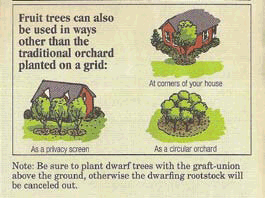Green Horizons
Volume 18, Number 2Spring 2014
Fruit trees as landscape trees?
By EUGENE L. BRUNK
We foresters, and arborists to some extent, rarely think of using fruit trees as part of a home landscaping plan. Also, many homeowners seldom ask about fruit trees.
Perhaps both groups need a reminder that a home fruit orchard can be a delight to the eye and the palate. Many standard varieties of apples, pears, peaches, apricots, plums and cherries are also good shade trees, if planted in the right place. Dwarf trees that produce full-sized fruit can be used in smaller spaces, like under overhead electrical lines. Fruit trees can be just as lovely as flowering trees and large shrubs. They blossom too, and the fruit crop gives the color of a second blooming all summer.
Fruit trees are either self-pollinating or self-sterile. Self-sterile trees require pollen from another cultivar of the same species for fertilization to occur. They need a compatible cultivar growing within 100 feet. Without this cross pollination of the flowers, self-sterile varieties will not bear fruit, even though they may produce mant flowers.
Plant fruit trees to allow sun and space for their mature size. Most standard sized fruit trees will mature at 20 - 35 feet in height. Dwarf varieties will mature at about 8 - 15 feet in height. Most commercially grown varieties will come with spacing recommendations, along with other pertinent information about the tree.
Homeowners with larger lots might find it very rewarding to establish an orchard using favored fruit producers. A homegrown apple or peach tastes mighty good when plucked from your own tree. My mouth is already watering for a nice juicy pear, apple, or peach, or apricot (I love ‘em), or cherry, or plum!
 |
||
ILLUSTRATION COURTESY OF EUGENE L. BRUNK |
||